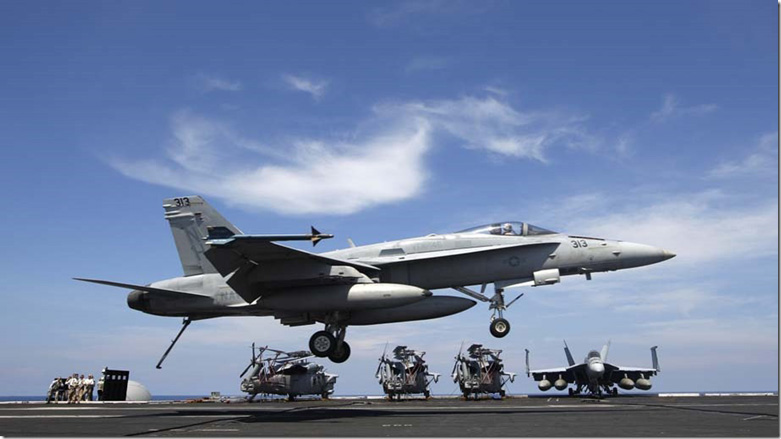Iranian belligerence toward the US continues

WASHINGTON DC, United States (Kurdistan24) – Iranian acts of aggression toward the US have continued despite the new Congressionally-mandated sanctions on the country.
On Tuesday, an Iranian drone flew in close proximity to a Navy fighter jet, operating in international airspace, as the jet prepared to land on a US aircraft carrier in the Persian Gulf.
The F/8-18E Super Hornet was obliged to take evasive action to avoid a collision with the Iranian QOM-1 drone.
Defense Department spokesman Adam Stump explained in a written statement to Kurdistan24 that a mere 100 feet separated the two aircraft, while the drone’s operator ignored “repeated radio calls” to keep it away.
Stump denounced the “dangerous maneuver,” which “created a collision hazard.” It was “the 13th unsafe and/or unprofessional interaction between US and Iranian maritime forces in 2017,” he stated.
The aircraft carrier, the USS Nimitz, replaces another carrier, the USS George H. W. Bush, and is in the region to support military operations against the Islamic State (IS) in Iraq and Syria.
Paul Davis, a retired Army intelligence analyst, told Kurdistan24 that a drone coming within 100 feet of an approaching fighter is “incredibly dangerous, not just for the pilot, but also for the deck crew.” Casualties could easily have occurred.
The event reminded Davis of encounters with the Russian navy during the Cold War, when the Soviets carried out mock attacks and close maneuvers to test the US reaction.
“I suspect the Iranians are doing much the same,” he said.
In addition, the leader of an Iraqi Shi’ite militia falsely claimed on Tuesday that US airstrikes had killed dozens of his fighters, along with seven members of the Iranian Revolutionary Guard Corps, apparently acting as advisors.
The strike allegedly occurred close to the border between Iraq and Syria, near the al-Walid border crossing, which sits astride the Baghdad-Damascus highway. The US maintains a camp on the Syrian side, at al-Tanf, where it is training Syrian Arabs to fight IS.
The Shiite leader complained that Baghdad was not allowing his forces to start operations in Western Anbar, affirming they were “determined to liberate it,” describing the area as one of great strategic importance, according to the “IranObserved Project” of Washington’s Middle East Institute.
The border crossing is a key point in Iran’s effort to build a land corridor from Tehran to the Mediterranean.
On Wednesday, State Department Spokesperson Heather Nauert joined the Pentagon in flatly denying that US planes had attacked the Iraqi militia.
The US-led “coalition did not conduct any strikes in that area on that date and at that time,” she said in response to a question from Kurdistan24.
IS subsequently claimed responsibility for the attack, and the Shiite commander charged that the US and IS were colluding together.
“The assertion that the coalition is conducting operations with [IS] is simply preposterous,” Nauert affirmed, adding that the US and IS “have nothing to do with one another other than that they [IS] are a target of ours [US].”
In other news, a State Department official, in a written statement to Kurdistan24, clarified a point of confusion regarding Secretary of State Rex Tillerson’s communications with the President of the Kurdistan Region, Masoud Barzani.
On Friday, State Department officials claimed that Tillerson had spoken with Iraqi Prime Minister Haidar al-Abadi and with Barzani. However, Barzani’s office subsequently said no conversation occurred. One was scheduled, as Kurdistan24 learned, but it was never held.
The call to Abadi did occur, the State Department said on Wednesday, and while the call to Barzani had not taken place, we expect it “to happen soon.”
Editing by G.H. Renaud
